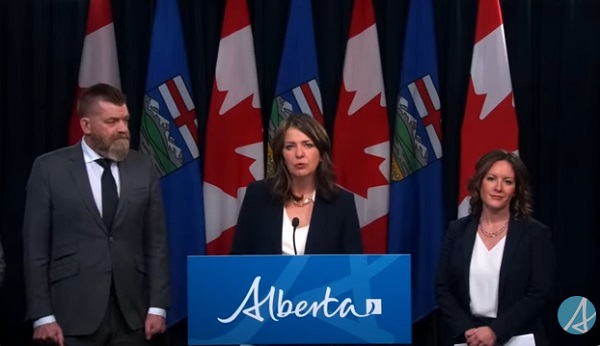Alberta
Protecting Alberta’s economic future from Ottawa

Alberta’s government will introduce an Alberta Sovereignty Within a United Canada Act motion to fight back against the unconstitutional, job-killing federal emissions cap.
The proposed oil and gas emissions cap is in reality a federal government-imposed cap on oil and gas production and, if implemented, will result in a production cut of at least one million barrels a day of oil and gas in Alberta, while effectively prohibiting any production growth.
The Canadian constitution clearly gives provinces exclusive jurisdiction over non-renewable natural resource development. Multiple reports have shown an emissions cap will kill 150,000 jobs, devastate Alberta’s economy, cut production, and hurt Albertans.
Yet, on Nov. 4, the federal government introduced draft regulations for an oil and gas emissions cap, ignoring concerns from many provinces, industry, businesses and Albertans.
In response, Alberta’s government will introduce an Alberta Sovereignty Within a United Canada Act motion to stop a federal cap from infringing on the province’s distinct jurisdiction and killing good-paying jobs. The resolution asks the legislative assembly for approval to take a series of swift, effective actions designed to protect Alberta if the production cap ever becomes law.
“We will continue to defend our province from Ottawa’s senseless and direct attack. Our motion protects Albertans’ jobs and livelihoods, puts Ottawa back in their place, and ensures we can continue to support global energy security with Alberta oil and gas for decades to come.”
Independent analysis by the Conference Board of Canada, Deloitte and S&P Global all show the devastating impact of the federal government’s proposed oil and gas emissions cap. This includes cutting production by one million barrels a day by 2030 and draining billions from Canada’s economy. In addition, the Conference Board of Canada estimates that up to 150,000 Canadian jobs could be lost as a result of the cap. As a result of these – and other – impacts, the average Canadian family would have up to $419 less for groceries, mortgage payments and utilities every month.
“This cap is not actually about emissions. This is about the federal government wanting to cut oil and gas production and control our energy sector, even if it costs thousands of jobs and hurts Canadians from coast to coast. We are standing up for our province and protecting Albertans from this extreme federal overreach.”
If passed, the actions proposed in the Alberta Sovereignty Within a United Canada Act motion will help protect Alberta’s economy while the province continues producing responsible energy to meet the world’s growing demands.
The motion proposes that the government launch an immediate constitutional challenge when, or if, the federal production cap becomes law. It also instructs the government to consider passing legislation, amending provincial regulations or taking whatever other steps are needed to:
- Ensure that no provincial entity participates in the enforcement or implementation of the federal cap.
- Ensure that all interest holder oil and gas production facilities and related infrastructure in Alberta (Interest Holder Facilities) are ‘essential infrastructure’ subject to the protections granted under Alberta’s Critical Infrastructure Defence Act.
- Prohibit entry by any individual, including any federal official or contractor, onto any Interest Holder Facilities, excepting any interest holders, employees and contractors, and those specifically licensed to enter by the Government of Alberta.
- Declare all information that is directly or indirectly related to greenhouse gas, collected at Interest Holder Facilities, as proprietary information exclusively owned by the Government of Alberta, and mandate that all emissions data be reported and disclosed at the province’s discretion.
- Effectively sell conventional oil through the Conventional Oil Royalty-in-Kind program, and work collaboratively with industry to implement a Bitumen Royalty-in-Kind program for bitumen, and develop a similar program for natural gas, if necessary.
- Work collaboratively and proactively with other provinces and territories, the United States and First Nations to double oil and gas pipeline capacity to tidewater and the United States of America.
If the motion is passed, Alberta’s government will immediately begin taking steps to be ready to protect the province if the federal regulations become law.
Quick facts:
- Alberta has repeatedly expressed that the federal cap is unconstitutional and impermissibly intrudes into an area of exclusive provincial jurisdiction as set out in section 92A of the Constitution Act, 1867.
- The Conference Board of Canada forecasts that royalties in Alberta will drop by $2-4 billion in 2030-31 under the emissions cap.
- Deloitte forecasts a $26 billion cut to Canada’s overall GDP in 2035, including a $16 billion decline in the GDP produced by oil and gas. It forecasts a five per cent decline in revenue for Alberta by 2035.
- Via the ScraptheCap.ca, over 4,000 people have sent letters to their Members of Parliament and federal ministers, and there have been over 12 million views of the current video online.
- Albertans and Canadians can continue to use the website to send letters.
Related information
Alberta
CPP another example of Albertans’ outsized contribution to Canada

From the Fraser Institute
By Tegan Hill
Amid the economic uncertainty fuelled by Trump’s trade war, its perhaps more important than ever to understand Alberta’s crucial role in the federation and its outsized contribution to programs such as the Canada Pension Plan (CPP).
From 1981 to 2022, Albertan’s net contribution to the CPP—meaning the amount Albertans paid into the program over and above what retirees in Alberta received in CPP payments—was $53.6 billion. In 2022 (the latest year of available data), Albertans’ net contribution to the CPP was $3.0 billion.
During that same period (1981 to 2022), British Columbia was the only other province where residents paid more into the CPP than retirees received in benefits—and Alberta’s contribution was six times greater than B.C.’s contribution. Put differently, residents in seven out of the nine provinces that participate in the CPP (Quebec has its own plan) receive more back in benefits than they contribute to the program.
Albertans pay an outsized contribution to federal and national programs, including the CPP because of the province’s relatively high rates of employment, higher average incomes and younger population (i.e. more workers pay into the CPP and less retirees take from it).
Put simply, Albertan workers have been helping fund the retirement of Canadians from coast to coast for decades, and without Alberta, the CPP would look much different.
How different?
If Alberta withdrew from the CPP and established its own standalone provincial pension plan, Alberta workers would receive the same retirement benefits but at a lower cost (i.e. lower CPP contribution rate deducted from our paycheques) than other Canadians, while the contribution rate—essentially the CPP tax rate—to fund the program would likely need to increase for the rest of the country to maintain the same benefits.
And given current demographic projections, immigration patterns and Alberta’s long history of leading the provinces in economic growth, Albertan workers will likely continue to pay more into the CPP than Albertan retirees get back from it.
Therefore, considering Alberta’s crucial role in national programs, the next federal government—whoever that may be—should undo and prevent policies that negatively impact the province and Albertans ability to contribute to Canada. Think of Bill C-69 (which imposes complex, uncertain and onerous review requirements on major energy projects), Bill C-48 (which bans large oil tankers off B.C.’s northern coast and limits access to Asian markets), an arbitrary cap on oil and gas emissions, numerous other “net-zero” targets, and so on.
Canada faces serious economic challenges, including a trade war with the United States. In times like this, it’s important to remember Alberta’s crucial role in the federation and the outsized contributions of Alberta workers to the wellbeing of Canadians across the country.
Alberta
Made in Alberta! Province makes it easier to support local products with Buy Local program

Show your Alberta side. Buy Local. |
When the going gets tough, Albertans stick together. That’s why Alberta’s government is launching a new campaign to benefit hard-working Albertans.
Global uncertainty is threatening the livelihoods of hard-working Alberta farmers, ranchers, processors and their families. The ‘Buy Local’ campaign, recently launched by Alberta’s government, encourages consumers to eat, drink and buy local to show our unified support for the province’s agriculture and food industry.
The government’s ‘Buy Local’ campaign encourages consumers to buy products from Alberta’s hard-working farmers, ranchers and food processors that produce safe, nutritious food for Albertans, Canadians and the world.
“It’s time to let these hard-working Albertans know we have their back. Now, more than ever, we need to shop local and buy made-in-Alberta products. The next time you are grocery shopping or go out for dinner or a drink with your friends or family, support local to demonstrate your Alberta pride. We are pleased tariffs don’t impact the ag industry right now and will keep advocating for our ag industry.”
Alberta’s government supports consumer choice. We are providing tools to help folks easily identify Alberta- and Canadian-made foods and products. Choosing local products keeps Albertans’ hard-earned dollars in our province. Whether it is farm-fresh vegetables, potatoes, honey, craft beer, frozen food or our world-renowned beef, Alberta has an abundance of fresh foods produced right on our doorstep.
Quick facts
- This summer, Albertans can support local at more than 150 farmers’ markets across the province and meet the folks who make, bake and grow our food.
- In March 2023, the Alberta government launched the ‘Made in Alberta’ voluntary food and beverage labelling program to support local agriculture and food sectors.
- Through direct connections with processors, the program has created the momentum to continue expanding consumer awareness about the ‘Made in Alberta’ label to help shoppers quickly identify foods and beverages produced in our province.
- Made in Alberta product catalogue website
Related information
-

 International1 day ago
International1 day agoPope Francis has died aged 88
-

 International1 day ago
International1 day agoPope Francis Dies on Day after Easter
-

 International24 hours ago
International24 hours agoJD Vance was one of the last people to meet Pope Francis
-

 2025 Federal Election12 hours ago
2025 Federal Election12 hours agoPOLL: Canadians want spending cuts
-

 Business1 day ago
Business1 day agoCanada Urgently Needs A Watchdog For Government Waste
-

 Energy1 day ago
Energy1 day agoIndigenous-led Projects Hold Key To Canada’s Energy Future
-

 2025 Federal Election1 day ago
2025 Federal Election1 day agoCarney’s budget means more debt than Trudeau’s
-

 2025 Federal Election13 hours ago
2025 Federal Election13 hours agoOttawa Confirms China interfering with 2025 federal election: Beijing Seeks to Block Joe Tay’s Election






